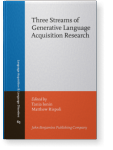When OR is conjunctive in child Mandarin
According to a recent proposal, children license a conjunctive inference for statements with disjunction even without a licensing expression that adults require, e.g., the deontic modal verb is allowed to (Singh, Wexler, Astle, Kamawar, & Fox, 2016; Tieu et al., 2017). However, the rates of children’s conjunctive inferences vary considerably across studies, which may be due to the different experimental tasks and materials. Using a Truth Value Judgment Task (Crain & Thornton, 1998), the present study systematically investigated children’s interpretation of disjunctive sentences with and without a deontic modal verb. It was found that children computed conjunctive inferences only in sentences with the deontic modal verb. We discuss the possible reasons for the varying findings of children’s interpretation of disjunction in previous studies.
Article outline
- 1.Introduction
- 2.Literature review
- 2.1Children’s conjunctive interpretation of disjunction
- 2.2Children’s interpretation of disjunction
- 2.3Children’s computation of free choice inferences
- 3.Experiments
- 3.1Experiment 1
- 3.2Experiment 2
- 4.Discussion and conclusion
-
Acknowledgements
-
References
